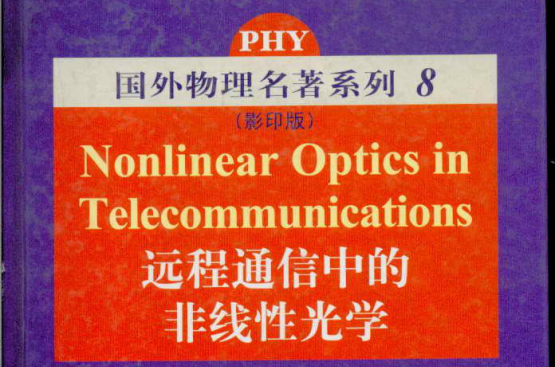基本介紹
- 書名:遠程通信中的非線性光學
- 作者:(德)施奈德(Schenider,T.)
- ISBN:9787030187901
- 頁數:415
- 出版社:科學出版社
- 出版時間:2007-4
- 裝幀:精裝
- 叢書名:國外物理名著系列8
- 版次:1
內容簡要,目錄,
內容簡要
更大的頻寬、更密的頻道間隔和更高的信號強度使得非線性效應在遠程通信系統性能中的作用更加重要。本書包含了作者豐富的實踐經驗和實驗結果,分別討論了非線性效應在信號處理、超快光學開關、波長轉換、非線性放大以及光學相位中的套用,本書作者——德國電信的施奈德(Thomas Schneider)向讀者展現了如何利用非線性效應來增加頻寬以及克服先前局限的創新想法。本書每章後配有總結和習題,可以作為研究生教材使用。
目錄
1.Introduction
Part I.Fundamentals of Linear and Nonlinear Optics
2.Overview of Linear Optical Effects
2.1 The Wave Equation for Linear Media
2.2 Solution of the Linear Wave Equation
2.3 The Harmonic Oscillator Model
2.4 Attenuation
2.5 Amplification
2.6 The Refractive Index
2.6.1 The Sellmeier Equation
2.6.2 Phase Velocity, Group Velocity, and Dispersion
2.7 Birefringence
Summary
Exercises
3.Optical Telecommumcations
3.1 Fiber Types
3.1.1 Step-Index and Graded-Index Fibers
3.2 Single Mode Fibers
3.2.1 Single Mode Fiber Types
3.3 Highly Nonlinear and Photonic Fibers
3.4 Modulation
3.5 Optical Transport Technologies
Summary
Exercises
4.Nonlinear Effects
4.1 The Nonlinear Oscillator
4.2 Nonlinear Polarization
4.3 The Nonlinear Susceptibility
4.3.1 Estimation of the Order of Magnitude
of the Susceptibilities
4.4 The Nonlinear Wave Equation
4.5 Second Order Nonlinear Phenomena
4.6 Third Order Nonlinear Phenomena
4.7 The Nonlinear Refractive Index
4.8 Effective Area and Nonlinear Coefficient
4.9 Effective Length
4.10 Phase Matching
4.11 Capacity Limit of Optical Fibers
Summary
Exercises
Part II.Nonlinear Effects in Optical Waveguides
5.The Nonlinear Schrödinger Equation
5.1 Derivation of the Nonlinear Schrödinger Equation
5.2 Dispersion and Nonlinear Length
5.3 The Linear Term
5.4 Dispersion Management
5.5 The Nonlinear Term
5.6 Numerical Solution of the NSE
Summary
Exercises
6.Self-and Cross-Phase Modulation
6.1 Self-Phase Modulation (SPM)
6.1.1 SPM\'s Impact on Communication Systems
6.1.2 Experimental Results
6.2 Cross-Phase Modulation (XPM)
6.2.1 Polarization Dependence of XPM
6.2.2 XPM\'s Impact on Communication Systems
Summary
Exercises
7.Four-Wave-Mixing (FWM)
7.1 Mixing between WDM Channels
7.2 Mathematical Description of FWM
7.3 Phase Matching
7.4 FWM\'s Impact on Communication Systems
7.5 FWM Suppression
7.6 Experimental Results
7.7 Polarization Dependence of FWM
7.7.1 Numerical Simulation
7.7.2 Results
Summary
Exercises
8.Intrachannel Nonlinear Effects
8.1 Mathematical Description
8.2 SPM and IXPM
8.3 IFWM and Ghost Pulses
8.4 IFWM Suppression
Summary
Exercises
9.Solitons
9.1 Mathematical Description
9.2 Higher Order Solitons
9.3 Limits of Solitons
9.3.1 The Gordon-Haus Effect
9.3.2 The Acoustic Effect
9.4 Increasing the Bit Rate in Soliton Systems
9.5 Mutual Interaction Between Solitons
9.6 Dispersion-Managed Solitons
Summary
Exercises
10.Raman Scattering
10.1 The Scattering of Light
10.2 Origin of Raman Scattering
10.2.1 Raman Scattering in the Harmonic Oscillator Model..244
10.3 Raman Scattering in Optical Fibers
10.3.1 Spontaneous and Stimulated Scattering
10.3.2 Threshold of Raman Scattering in Optical Waveguides 253
10.4 Impact of Raman Scattering on Communication Systems
Summary
Exercises
11.Brillouin Scattering
11.1 Scattering of Optical Waves at Sound Waves
11.2 Spontaneous and Stimulated Brillouin Scattering
11.3 The Brillouin Gain
11.3.1 Spectral Distribution
11.3.2 Frequency Shift
11.3.3 Gain Maximum
11.4 Threshold of Brillouin Scattering
11.5 SBS\'s impact on Communication Systems
11.6 Brillouin Scattering for Distributed Temperature and Strain Sensors
Summary
Exercises
Part III.Applications of Nonlinear Effects in Telecommunications
12.Optical Signal Processing
12.1 Spectrum Slicing and Nonlinear WDM Sources
12.2 Wavelength Conversion
12.2.1 Wavelength Conversion with FWM
12.2.2 Wavelength Conversion with XPM
12.2.3 Wavelength Conversion with SOA
12.3 Optical Switching
12.3.1 Photorefractive Optical Switches
12.3.2 Optical Switching with the XPM Effect
12.3.3 FWM for Optical Switching
12.3.4 Ultrafast Optical Switching
12.4 Retiming, Reshaping, and All-Optical Clock Recovery
12.5 Optical Filters with SBS
Summary
Exercises
13.Nonlinear Lasers and Amplifiers
13.1 Raman Amplifier
13.2 Raman Laser
13.3 Brillouin Amplifiers and Lasers
13.3.1 Radio-over-Fiber
13.4 Parametric Amplifiers
Summary
Exercises
14.Nonlinear Optical Phase Conjugation
14.1 Phase-Conjugating Mirrors
14.2 Distortion Compensation due to Phase Conjugation
14.3 Theoretical Description of NPC
14.4 Phase Conjugation as Holographic Model
14.5 Mid-span Spectral Inversion
Summary
Exercises
A.Appendices
A.1 div, grad, curl, rot
A.2 The Gaussian Pulse
A.3 Logarithmical Units
References
Index

